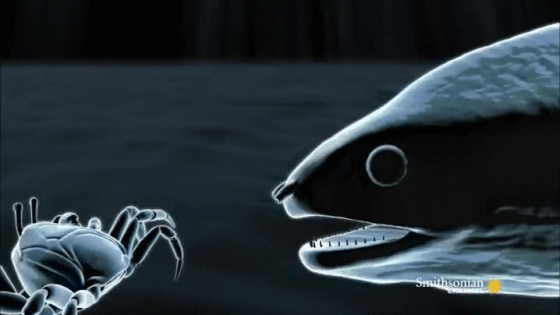It’s been a while since my last post in English, which means that ideas have been steadily accumulating in my ‘to write’ folder. Some of these ideas come from my own experience with PhD applications and interviews (and the help and advice I was selflessly offered), which hopefully will be of use for someone going through similar situations in the future. Other ideas are shaping up towards something like a series of interviews, with a focus on bringing out the people behind a sometimes dehumanised science.
But that’s not what I want to talk about today. Today I bring you nature at its wildest. Today I bring you three creatures that might as well appear in the upcoming J.K. Rowling movie. Well… Except the first one… The first one has enough movies already. Over the past couple of months I have read about some really curious fellows, and I decided to bookmark them and share them with you. Yes, yes, you can thank me later. For now, join me for a trip into some of the most fantastic and unimaginable corners of our planet.
An Eel with an Alien bite
Let’s assume you’ve watched Ridley Scott’s Alien, perhaps even a sequel. Remember the smaller yet deadlier protruding set of jaws of the alien? Well, guess what, that alien bite might as well be more terrestrial than you thought. Meet the Moray Eel.

You can’t stop watching it, right? It’s mental. Are you curious to know what’s that all about? Here it goes. Most bony fishes capture their prey using what’s called suction feeding: when their supper is within reach, they open and expand their mouth cavity, thus creating negative pressure that sucks the prey down their throats like a vacuum. This suction leads the food to a second set of jaws inside their throats, the pharyngeal jaws, which will aid in manipulating and swallowing the prey. This feeding strategy works especially well if whatever you are trying to eat is small enough to fit in your mouth.
However, the moray eel is not most bony fishes, and it turns out that its suction-feeding abilities are below average. Plus it is a greedy fish, and usually tries to swallow large fish and cephalopods. To overcome such a problem and satisfy its appetites, the moray eel has an extremely mobile set of pharyngeal jaws, and it can launch them out of its throat into its oral cavity to bite the prey and drag it back inside the throat and towards the oesophagus. Exactly, when you thought you’d seen it all… If you want to learn more about the real alien, check out the paper published in Nature.
A Jellyfish from another World
Moving on to calmer and deeper waters we encounter one of the discoveries of the Okeanos Explorer, a jellyfish so bizarre that my very first thought was ‘this can’t be real, it must be photoshopped’.
But it is not photoshopped. And it is real. You can learn a bit more about this surreal jellyfish, which was discovered 3700 meters deep, in the following link. The Okeanos Explorer is a ship from the NOAA (National Oceanic and Atmospheric Administration) assigned to explore the largely unknown areas of the oceans. From April 20th to July 10th 2016 it will be in the Pacific Ocean exploring the Marianas Trench together with its ROV (Remotely Operated underwater Vehicle) Deep Discoverer. If you are into it, you can browse the log of photos and videos from the expedition here for more amazing discoveries, and you can even watch a live-feed of the exploration.
A Bollywoodian Spider
Finally, to end on a cheerful note, let’s sail away from deep waters and towards Australia in order to dance… with Peacock Spiders. Wait, what? Hold on, hold on. Read a bit more before taking out your shoes and attempting to mercilessly smash them.
Peacock spiders are a genus of the jumping spiders’ family and are very tiny, about 5 millimetres long. This means that you can keep your shoes on because they pose no threat to you (plus you’d probably miss anyway). Females are usually brown, camouflaged and very difficult to spot. However, males are the exact opposite and have very colourful and highly ornate tail flaps. And they dance like nothing you’ve seen before. That’s right, in order to attract or court a female, males put on extraordinary performances. See for yourself, meet the seven newly discovered species and their dance moves in this video footage featured in National Geographic.
Aren’t they cute? And you wanted to smash them with your shoe… Thanks to the field work of Jürgen Otto and David Knowles, you can behold the stunning beauty of up to 48 species of peacock spider. Go to Jürgen Otto’s YouTube channel for more videos, or to the Facebook page dedicated to this tiny flashy arachnids. You might as well enjoy reading the articles featured in National Geographic here and here.
Well, that’s all folks, enjoy the rest of the day! Although if you still have some coffee left, here’s a bonus video from Al Jazeera:
Alright, alright, back to work.


[…] creatures that roam around this planet. I already wrote about some of them a while ago (you can check it out here), but the truth is that there are many more awaiting to be discovered and ready to blow our minds. […]
LikeLike
[…] What would you do if someone (or something) came at you with the unashamedly obvious intention of eating you? Would you try to outwit it by dressing up and becoming part of the scenery? Would you make use of your ninja skills and kick it in the face before running away? Or would you keep it cool and wait until this someone (or something) suddenly realised it doesn’t actually have the guts to digest you? Whatever imaginary stratagem your mind is plotting right now has the potential to be vastly overshadowed by what you are about to read. Welcome to the 2019 edition of Fantastic Creatures. […]
LikeLike